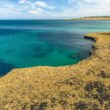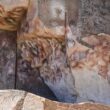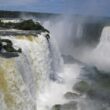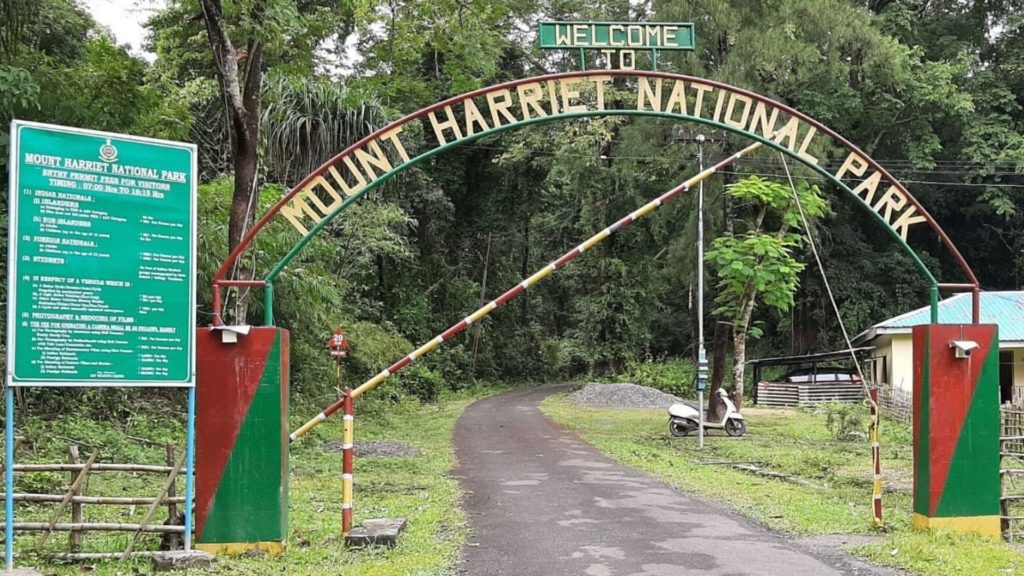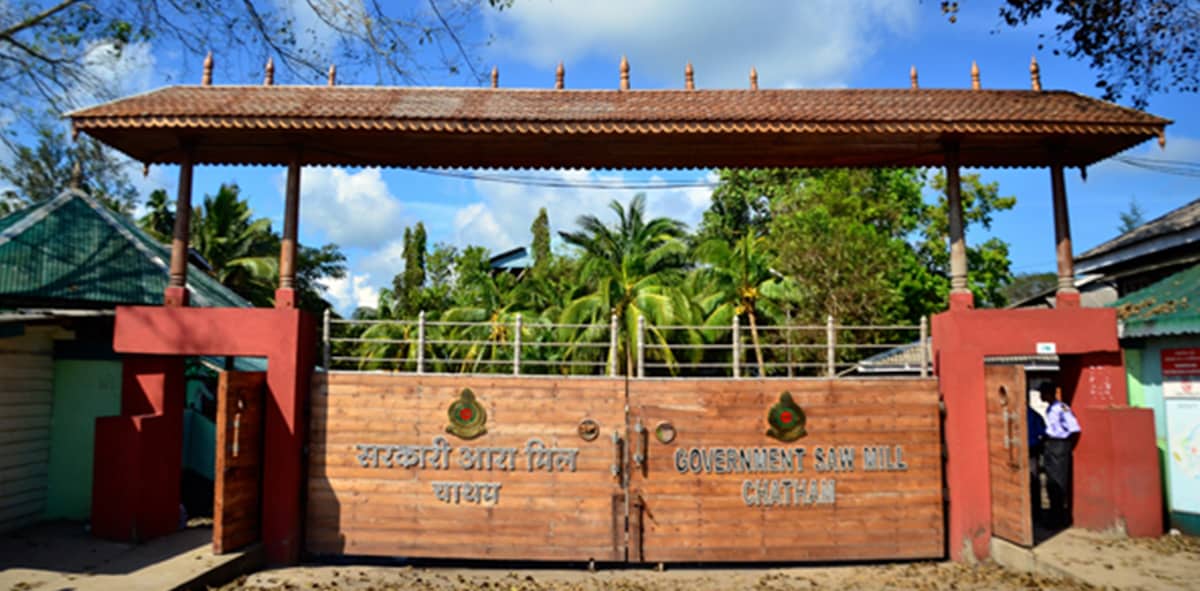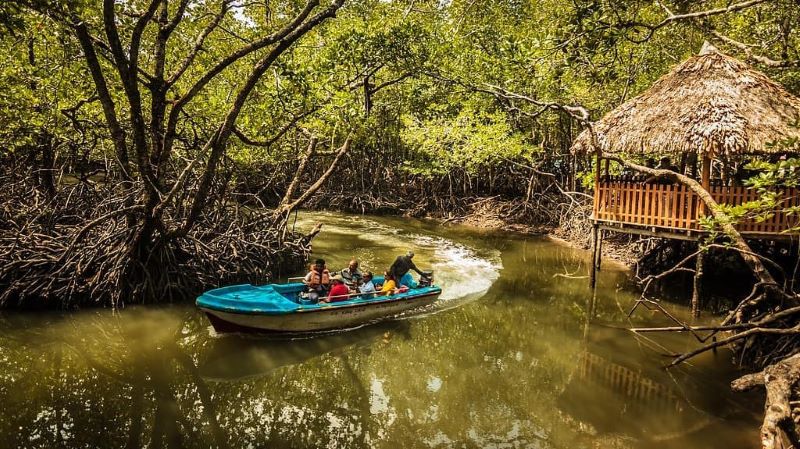Mount Harriet National Park is a beautiful and diverse natural area located in the Andaman and Nicobar Islands of India. The park covers an area of about 45 square kilometers and is home to a wide variety of plant and animal life, as well as several historical sites.
The park is named after Mount Harriet, the highest peak in the Andaman and Nicobar Islands. The mountain, which stands at an elevation of 365 meters, offers stunning views of the surrounding islands and the Bay of Bengal. Visitors can hike to the summit to take in the panoramic vistas or simply enjoy the natural beauty of the mountain from one of the many viewpoints along the way.
The park is also home to a rich variety of plant and animal life. The dense forests of the park are home to a wide variety of trees and shrubs, including mangroves, mangrove associates, and tropical evergreens. Visitors can also see a wide variety of birds, including parakeets, pigeons, and hornbills, as well as reptiles, such as lizards and snakes.
In addition to the natural beauty, Mount Harriet National Park also has a rich history. The park is home to several historical sites, including Mount Harriet Light House, which was built in 1885 and offers a great view of the surrounding islands. Visitors can also see the ruins of a British settlement and the cellular jail, which was used to imprison political prisoners during the colonial era.
Mount Harriet National Park is a must-see destination for nature lovers and history buffs alike. The park is easily accessible by ferry from Port Blair and is open year-round. Visitors can hike, bird watch, or simply relax and take in the natural beauty of the island.
History of Mount Harriet National Park
Mount Harriet National Park has a rich history that dates back to the colonial era. The park was originally used as a strategic location by the British during their occupation of the Andaman and Nicobar Islands.
In 1885, the British built Mount Harriet Light House on the highest peak of the island, which stands at an elevation of 365 meters. The lighthouse was used as a navigational aid for ships passing through the Bay of Bengal. It is still functional today and offers a great view of the surrounding islands.
During the colonial era, the island was also used as a hill station for British administrators. They built several bungalows and other buildings that served as a retreat from the heat and humidity of the low-lying islands. Some of these buildings still exist today and can be seen by visitors.
The Cellular jail, also known as Kala Pani, built by the British in the late 19th century, was used to imprison political prisoners during the colonial era. Many Indian freedom fighters were imprisoned and tortured in this jail during the struggle for India’s independence. The ruins of the jail still exist and are a popular attraction among tourists.
After India’s independence, the Andaman and Nicobar Islands declared a Union Territory of India. In 1979, Mount Harriet was declared a National Park, covering an area of 45 sq km, to protect the natural beauty and diverse wildlife of the island.
Today, Mount Harriet National Park is a popular destination for nature lovers and history buffs. The park is easily accessible by ferry from Port Blair and is open year-round. Visitors can hike, bird watch, or simply relax and take in the natural beauty of the island and also learn about the historical significance of the place.
Geography of Mount Harriet National Park
Mount Harriet National Park is located in the Andaman and Nicobar Islands of India, which are located in the Bay of Bengal. The park covers an area of approximately 45 square kilometers and is situated on the southern tip of South Andaman Island.
The park is named after Mount Harriet, the highest peak in the Andaman and Nicobar Islands. The mountain stands at an elevation of 365 meters and offers stunning views of the surrounding islands and the Bay of Bengal. Visitors can hike to the summit to take in the panoramic vistas or simply enjoy the natural beauty of the mountain from one of the many viewpoints along the way.
The park’s landscape is characterized by dense tropical evergreen forests, mangroves, and mangrove associates. The park is also home to a wide variety of plant and animal life, including a wide variety of birds such as parakeets, pigeons, and hornbills, as well as reptiles, such as lizards and snakes.
The park is situated on the coast and offers several beaches with crystal clear waters and white sandy beaches. Visitors can enjoy swimming, snorkeling, and scuba diving in the waters around the park.
The park is also located in an area that is prone to natural disasters such as cyclones, tsunamis and earthquakes. The park’s management has to be aware of these potential hazards and take the necessary precautions to ensure the safety of visitors.
In summary, Mount Harriet National Park is a beautiful and diverse natural area located in the Andaman and Nicobar Islands of India. The park covers an area of about 45 square kilometers and is characterized by dense tropical evergreen forests, mangroves, and mangrove associates, with a variety of plant and animal life and also offers several beaches with crystal clear waters. The park is also prone to natural disasters, so visitors should be aware of potential hazards.
Flora of Mount Harriet National Park
Mount Harriet National Park is home to a diverse array of plant life. The park is characterized by dense tropical evergreen forests, mangroves, and mangrove associates.
The tropical evergreen forests are composed of a wide variety of trees and shrubs, including species such as Andaman Padauk, Andaman Rats Tail, Andaman Redwood, and Andaman Silver Oak. These forests are home to a wide variety of animals, including birds, lizards, and snakes.
The park is also home to mangroves, which are salt-tolerant trees and shrubs that grow in coastal areas. These mangrove forests provide important habitats for a wide variety of wildlife, including fish, crustaceans, and birds. The mangrove associates, also known as beach forests, are characterized by the presence of Coconut, Casuarina, and Sea hibiscus.
The park is also home to a wide variety of medicinal plants. Many of these plants are used in traditional medicine by the local people. Some of the important medicinal plants found in the park are Andaman Padauk, Andaman Rats Tail, Andaman Redwood, and Andaman Silver Oak.
In summary, Mount Harriet National Park is a diverse and unique natural area, characterized by dense tropical evergreen forests, mangroves, mangrove associates, and also a variety of medicinal plants that are used by the local people. These different types of plants provide important habitats for a wide variety of wildlife, making the park a great destination for nature lovers and conservationists alike.
Fauna of Mount Harriet National Park
Mount Harriet National Park is home to a wide variety of fauna. The park’s dense tropical evergreen forests, mangroves, and mangrove associates provide important habitats for a diverse array of animals.
The park is home to a wide variety of birds, including parakeets, pigeons, and hornbills. Visitors can also see a variety of reptiles such as lizards, geckos, and snakes like the Andaman Pit Viper and the Andaman Wolf Snake.
The park’s coastal areas are also home to a variety of marine life, including fish, crustaceans, and sea turtles. Visitors can see a variety of species such as clownfish, parrotfish, and several types of coral reefs.
The park is also home to a variety of mammals such as the Andaman Wild Pig, the Andaman Spotted Deer, and the Nicobar Long-tailed Macaque. Visitors may also see the saltwater crocodile around the mangrove areas.
The park is an important breeding ground for the Leatherback sea turtle and the Olive Ridley sea turtle. Visitors can see these sea turtles nesting on the beaches during the breeding season.
In summary, Mount Harriet National Park is home to a diverse array of fauna, including a wide variety of birds, reptiles, marine life, and mammals. The park’s dense tropical evergreen forests, mangroves, and mangrove associates provide important habitats for this wildlife, making it a great destination for nature lovers and conservationists alike. The park is also an important breeding ground for sea turtles, making it a great place to see these magnificent creatures during the breeding season.
Trekking in Mount Harriet National Park
Mount Harriet National Park offers a wide variety of trekking opportunities for visitors. The park is named after Mount Harriet, the highest peak in the Andaman and Nicobar Islands, which stands at an elevation of 365 meters. The mountain offers a challenging and rewarding trek for visitors.
The trek to the summit of Mount Harriet begins at the Mount Harriet Light House. The trail to the summit is well-marked and takes visitors through dense tropical evergreen forests, mangroves, and mangrove associates. The trek is considered moderate in difficulty and can take anywhere from 2-4 hours, depending on the fitness level of the trekker. Along the way, visitors can see a wide variety of plants and animals, including birds, lizards, and snakes.
The summit of Mount Harriet offers panoramic views of the surrounding islands and the Bay of Bengal. Visitors can also see the ruins of a British settlement and the cellular jail, which were used during the colonial era.
Visitors can also trek to the Madhuban Dam, which is a great place to see a variety of birds. The trek is an easy one and takes about an hour to complete. Another trek is the one to the Mini Zoo, which is a small zoo that is home to a variety of animals such as the Andaman wild pig, the Andaman Spotted Deer, and the Nicobar Long-tailed Macaque.
In summary, Mount Harriet National Park offers a wide variety of trekking opportunities for visitors. The trek to the summit of Mount Harriet is a challenging and rewarding experience, offering panoramic views and the chance to see a wide variety of plants and animals. Visitors can also trek to other places like the Madhuban Dam, Mini Zoo, and other places within the park to see a variety of birds and animals.
Similar Articles
Things to Know Before You Visit Mount Harriet, National Park
If you are planning a visit to Mount Harriet National Park, there are a few things you should know to make the most of your trip.
- Weather: The park is located in a tropical climate and experiences high humidity and temperatures. The best time to visit is between November and May when the weather is milder. Visitors should also be prepared for sudden changes in weather, including rain, and carry appropriate clothing and rain gear.
- Permits: Visitors are required to obtain a permit from the Forest Department to enter the park. These permits can be obtained from the Forest Department office in Port Blair.
- Accommodation: There are a few forest rest houses and huts inside the park, but they are limited in number and need to be reserved in advance. Visitors can also stay in the nearby towns of Mount Harriet and Port Blair.
- Transportation: The park is easily accessible by ferry from Port Blair. Visitors can also hire a taxi or take a bus to reach the park. Visitors are also allowed to drive their own vehicles.
- Food and Water: Visitors should carry their own food and water as there are no food or water facilities inside the park. Visitors should also carry enough drinking water as the park is situated in an area with high humidity.
- Safety: Visitors should be aware that the park is located in an area that is prone to natural disasters such as cyclones, tsunamis, and earthquakes. Visitors should also be aware of the potential hazards and take the necessary precautions to ensure their safety.
- Conservation: The park is home to a wide variety of plant and animal life, and visitors are reminded to respect the park’s natural resources and not to disturb the wildlife or damage the plants. Visitors should also follow the park’s rules and regulations to ensure the conservation of the park’s natural resources.
In summary, Mount Harriet National Park is a beautiful and diverse natural area that offers a wide variety of activities for visitors. Visitors should be aware of the weather, permits, accommodation, transportation, food, water, and safety issues before visiting the park. Visitors should also be aware of the park’s conservation efforts and follow the park’s rules and regulations to ensure the preservation of the park’s natural resources.
How to Reach Mount Harriet National Park
Mount Harriet National Park is located in the Andaman and Nicobar Islands of India, which are situated in the Bay of Bengal. The park is easily accessible by several modes of transportation.
- By Air: The nearest airport to the park is Veer Savarkar International Airport in Port Blair. The airport is well-connected to major cities in India such as Kolkata, Chennai, and Delhi. From the airport, visitors can hire a taxi or take a bus to reach the park.
- By Ferry: Visitors can also reach the park by taking a ferry from Port Blair. The ferry ride takes about 2-3 hours and is a scenic way to reach the park. Visitors can also take a ferry to reach other islands in the Andaman and Nicobar Islands.
- By Road: Visitors can also reach the park by road. The park is located about 45 km from Port Blair. Visitors can hire a taxi or take a bus to reach the park. Visitors are also allowed to drive their own vehicles.
Once visitors reach the park, they can take a guided tour or explore the park on their own. Visitors should be aware that the park is located in an area that is prone to natural disasters such as cyclones, tsunamis, and earthquakes, and should take the necessary precautions to ensure their safety.
In summary, Mount Harriet National Park is easily accessible by air, ferry, and road. Visitors can fly to Veer Savarkar International Airport in Port Blair and then hire a taxi or take a bus to reach the park. Visitors can also take a ferry from Port Blair to reach the park, or drive their own vehicles. Visitors should be aware of the potential hazards and take the necessary precautions to ensure their safety.
Attractions and Things to Do at Mount Harriet National Park
Mount Harriet National Park offers a wide variety of attractions and activities for visitors. Some of the most popular things to do at the park include:
- Hiking: The park is named after Mount Harriet, the highest peak in the Andaman and Nicobar Islands, which stands at an elevation of 365 meters. The mountain offers a challenging and rewarding trek for visitors. Visitors can hike to the summit to take in the panoramic vistas or simply enjoy the natural beauty of the mountain from one of the many viewpoints along the way.
- Bird Watching: The park is home to a wide variety of birds, including parakeets, pigeons, and hornbills. Visitors can also trek to the Madhuban Dam, which is a great place to see a variety of birds.
- Marine Life: The park’s coastal areas are also home to a variety of marine life, including fish, crustaceans, and sea turtles. Visitors can see a variety of species such as clownfish, parrotfish, and several types of coral reefs.
- Wildlife Viewing: The park is home to a variety of mammals such as the Andaman Wild Pig, Andaman Spotted Deer, and the Nicobar Long-tailed Macaque. Visitors may also see the saltwater crocodile around the mangrove areas.
- Sea Turtles: The park is an important breeding ground for the Leatherback sea turtle and the Olive Ridley sea turtle. Visitors can see these sea turtles nesting on the beaches during the breeding season.
- History: The park is home to several historical sites, including Mount Harriet Light House, which was built in 1885 and offers a great view of the surrounding islands. Visitors can also see the ruins of a British settlement and the cellular jail, which was used to imprison political prisoners during the colonial era.
- Beach activities: Visitors can enjoy swimming, snorkeling, and scuba diving in the waters around the park. The park offers several beaches with crystal clear waters and white sandy beaches.
In summary, Mount Harriet National Park offers a wide variety of activities and attractions for visitors, including hiking, bird watching, marine life, wildlife viewing, sea turtle nesting, historical sites, and beach activities. Visitors can enjoy a diverse range of experiences at the park and make the most of their visit.
Frequently Asked Questions About Mount Harriet National Park
Q. How do I get to Mount Harriet National Park?
A – The park is easily accessible by air, ferry, and road. Visitors can fly to Veer Savarkar International Airport in Port Blair and then hire a taxi or take a bus to reach the park. Visitors can also take a ferry from Port Blair to reach the park, or drive their own vehicles.
Q. What is the best time to visit Mount Harriet National Park?
A – The best time to visit the park is between November and May when the weather is milder. Visitors should also be prepared for sudden changes in weather, including rain, and carry appropriate clothing and rain gear.
Q. Do I need a permit to enter the park?
A – Yes, visitors are required to obtain a permit from the Forest Department to enter the park. These permits can be obtained from the Forest Department office in Port Blair.
Q. What kind of accommodations is available at the park?
A – There are a few forest rest houses and huts inside the park, but they are limited in number and need to be reserved in advance. Visitors can also stay in the nearby towns of Mount Harriet and Port Blair.
Q. Can I bring my own vehicle into the park?
A – Yes, visitors are allowed to drive their own vehicles into the park.
Q. Are there any food or water facilities inside the park?
A – No, there are no food or water facilities inside the park. Visitors should carry their own food and water. Visitors should also carry enough drinking water as the park is situated in an area with high humidity.
Q. What kind of natural hazards should I be aware of when visiting the park?
A – The park is located in an area that is prone to natural disasters such as cyclones, tsunamis, and earthquakes. Visitors should also be aware of the potential hazards and take the necessary precautions to ensure their safety.

